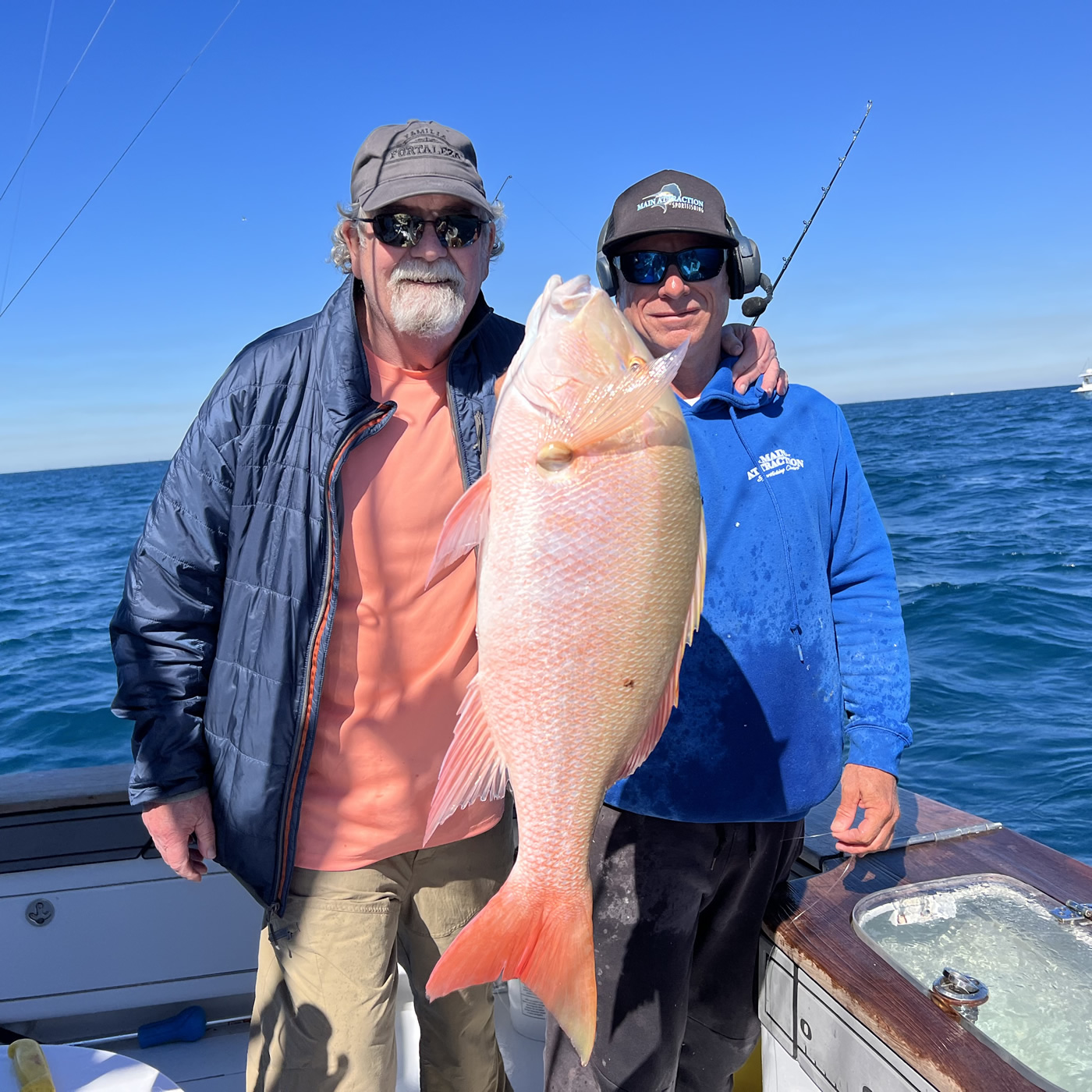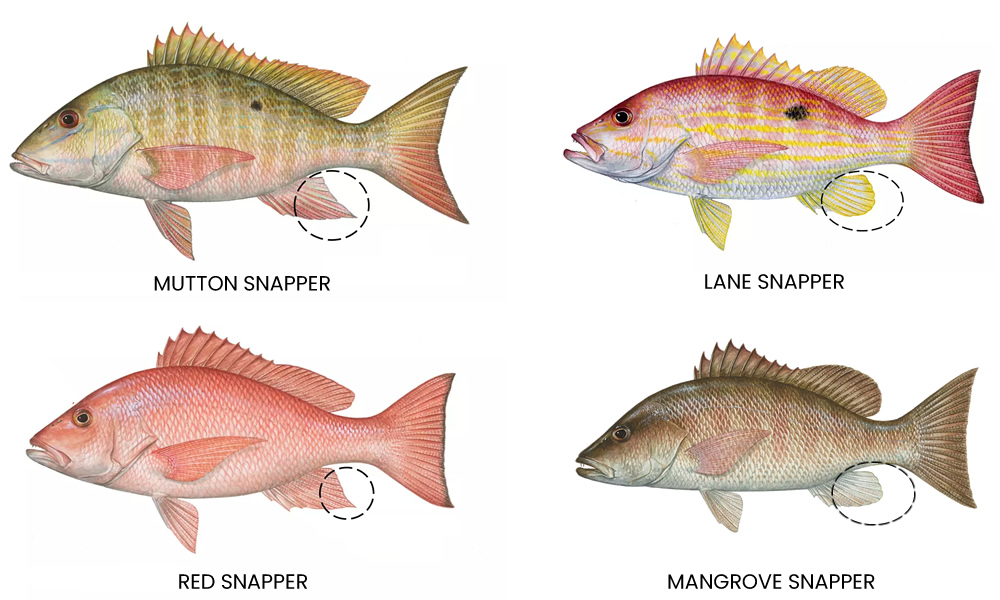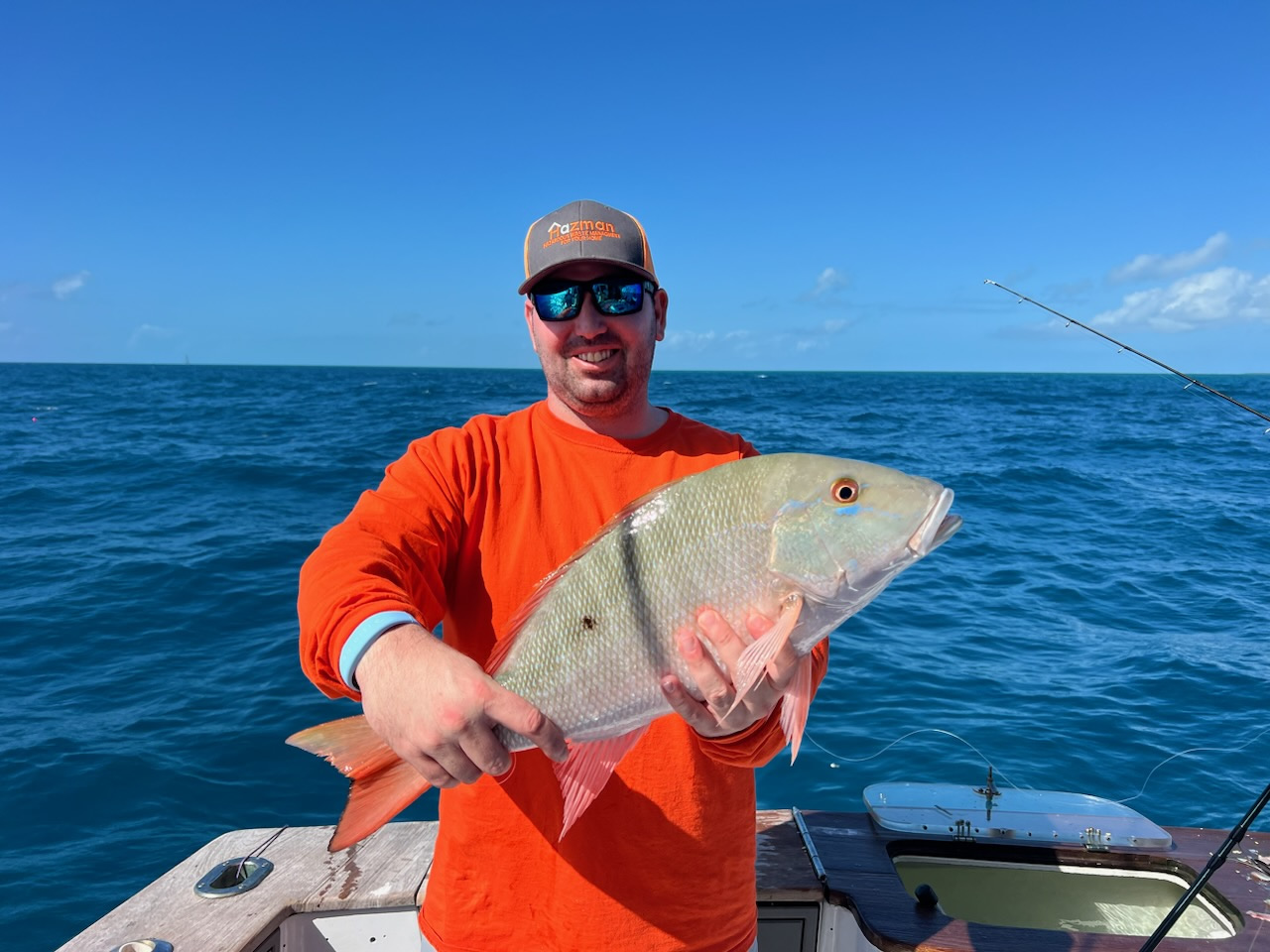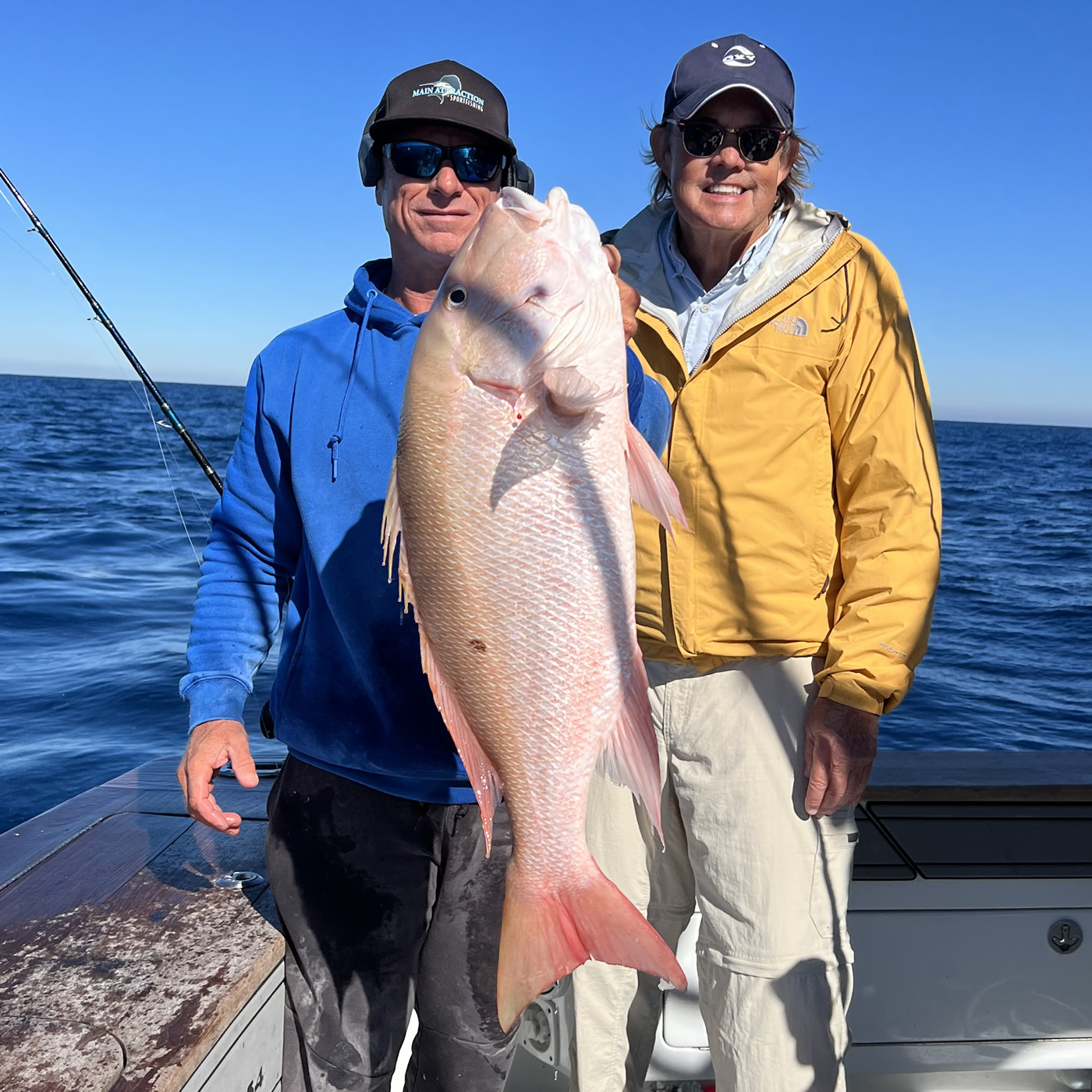All About Mutton Snapper – Florida Keys Mutton Snapper Facts
Last week we published an article about the secrets to successfully catching Mutton Snapper. We received such great feedback on it that we decided to spend some time learning more about this fascinating fish this week. We know how to catch it, but what else do we know about this intriguing fish?
The Mutton Snapper is scientifically known as Lutjanus analis. Analis refers to its pointed anal fin, which helps to identify it versus other juvenile snappers. Mutton Snappers belong to the family Lutjanidae which contains other famous members such as the Red Snapper, Yellowtail Snapper, and Mangrove Snapper.
The Mutton Snapper is a prized target for recreational and commercial fishermen due to its striking appearance, robust size, and delicious flesh.

Size and Growth
Mutton snappers can reach impressive sizes, making them a formidable opponent for anglers seeking a challenge on light tackle. They commonly grow to be 2-3 feet long. A Mutton Snapper may take up to 14 years or longer to reach its maximum length.
Adult Mutton Snappers can also weigh anywhere between 10 to 30 pounds. Florida Keys Mutton Snappers are often encountered around the 20-pound mark providing an exhilarating fight for anglers who manage to hook one.
Appearance
Mutton Snappers have that classic almond shape that most Snappers have along with a typical set of fins. The dark spot near their tails often identifies them along with some other fundamental differences from their counterparts.
Looking closely at an adult Mutton Snapper, you will see various hues, from silvery grays to olive, bright pink, red, and touches of blue. Adult male Mutton Snappers are often mistaken for Red Snapper, when their red tones are vibrant around spawn season. In Red Snapper, however, the coloration is only red, and there is no spot near the tail.

The spot on a Mutton Snapper is often the easiest way to tell a Mutton Snapper from a Red Snapper.
As juveniles, mutton snappers have a pattern of dark brown bars on their sides, which fade as they mature. Smaller Mutton Snappers are often misidentified as Mangrove Snappers when displaying a brown or silvery coloration.
A more accurate visual comparison to a Mutton would be the Lane Snapper. The Lane Snapper contains many of the same features as a Mutton, including its general coloration and a black spot near the tail; however, if you look more closely, you will see some differences.
Besides the most obvious difference (Muttons grow much larger than Lane Snappers) Mutton Snappers also have horizontal blue lines on their bodies, most distinguishable under the eye. Lane snappers instead have yellow lateral lines on their bodies. Also, the anal fin of a Mutton Snapper is much pointier than a Lane Snapper.
It is said that grayish-toned Muttons are in the sand, pink in the water column, and darker striped when feeding in the substrate; however, we could not find scientific data that corroborates this claim.

Gender
Telling the difference between a male or female mutton can be tricky at times. In many cases, a microscope would be required to tell for sure. However, there are easier, albeit less accurate, ways of telling the difference between the two.
Female Mutton Snappers grow larger than their male Counterparts. The Males are significantly brighter in hue than the females around mating season. Male Mutton Snappers also tend to have a more pronounced forehead or hump.
Sometimes a male Mutton Snapper’s vent may appear more pronounced than a female’s. The vent is an opening for these fish’s reproductive and excretory systems.
Mature females can sometimes be identified visually during mating season when they carry eggs in their swollen bellies.
Spawning and Reproduction
Mutton snappers gather in large groups to spawn, which typically occurs during the months of April through August. In the Florida Keys we find fishing for them best at the height of the spawn, which is near or on the full moon in June or July.
Smaller groups break from the massive gathering to spawn. Each Female Mutton Snapper in the group releases more than a million eggs into the water column, just as the male releases sperm to fertilize them. Ocean currents carry the fertilized eggs for about a day before they hatch. The larvae will settle in seagrass beds, where it will develop before moving on to coral reefs as it matures.
Life Span
Mutton snappers have relatively long lifespans. They can live for up to 40 years! Most fish, however, are harvested before reaching their maximum age.
Throughout their lives, Mutton Snappers spend most of their time in coastal waters near structures. In Marathon, Florida, we find juveniles in the shallows or on the reef and the adults in deeper waters, such as the edge of the reef or near sunken wrecks in depths up to 250ft.
Feeding
Mutton snappers are opportunistic predators; their diet consists of a wide variety of prey. They typically feed on crustaceans, mollusks, smaller fish, and even occasionally on squid. Mutton Snappers are able to change their feeding behaviors to adapt to what prey is available.
This versatility in diet contributes to their excellent growth rate and the high-quality meat they develop. It may also explain their cautious behavior, making them a challenging catch. Anglers should offer a variety of baits when trying to trigger a bite from these fish.

Fishing and Conservation
Mutton snappers are highly sought after by recreational and commercial anglers due to their delicious taste and fighting ability. Additionally, they are a popular alternative to the Red Snapper, which, historically the
Florida Fish and Wildlife Conservation Commission has been more strict with regulations.
The increase in the popularity of the Mutton Snapper as a target has led to population declines in some regions. While they still seem plentiful to us here in Marathon, in response to these changes, the FWC increased the minimum size requirement for harvest while reducing the daily bag limit. While populations are not yet in danger, preventive maintenance is the name of the game when protecting our amazing fishery.
Since July 1, 2020, anglers intending to harvest Mutton Snapper from a private recreational boat are required to sign up as a Florida State Reef Fish Angler. To sign up, call the FWC at 1-888-347-4356. If you fish aboard our charter vessels, this is not required as we have all the necessary licenses.

Red Snapper Populations Impact on Mutton Snapper
Many local fishermen have believed that populations of Red Snapper have exploded due to the more stringent approach to regulation. Many also feel strongly that restrictions on Red Snapper should be eased. On the Atlantic side in Federal waters, NOAA continues to enforce strict guidelines, only offering two days of recreational fishing this year, one week from today on July 14, and 15, 2023. (Source Link)
This means for boats like ours registered to fish in federal waters; Mutton Snapper is the only species similar to Red Snapper that we can harvest year round.
The FWC, however, has been easing regulations on Red Snapper in state waters. This past May, Governor Ron DeSantis announced the 2023 Gulf red snapper recreational season would be the longest combined season since the state took management of Red Snapper (72 days).
Easing restrictions on Red Snapper can help alleviate some pressure on Mutton Snapper while allowing recreational anglers to keep catching big beautiful, tasty snappers to grace their dinner table.
Culinary Delicacy
Mutton snappers are highly regarded for their culinary qualities. Their firm, white flesh is mild and slightly sweet, making them a popular choice for grilling, baking, or frying.
Mutton Snappers have a pleasant flavor: they do not need much more than a dash of salt & pepper, a drizzle of olive oil, and a splash of lemon juice, to be an incredible meal.
Like Red Snappers, Muttons make an impressive presentation when grilled whole and presented at the table on a large platter.
Conclusion
That concludes the seventh installment of our Fish Facts series, we hope you found it interesting. Headed to the Florida Keys? Consider a fishing charter for a memorable vacation! Call us at (305) 289-0071 or visit our contact page for more information.





